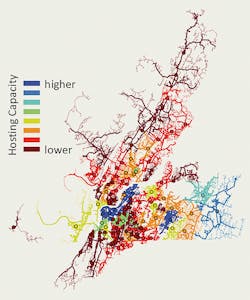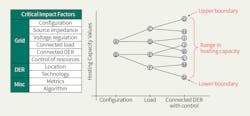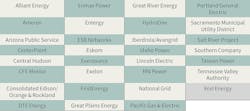Dom Fuda and Tom Russell also contributed to this article.
The electric power industry is increasingly having to evaluate the growing penetration of distributed energy resources (DER). New sets of challenges exist for planning and operating the grid, especially with the distribution systems in which these new resources must be integrated. Now electric utilities across the world are looking at new analytical methods to assess and integrate these resources.
In the United States, the New York State Public Service Commission launched the Reforming the Energy Vision initiative to more fully integrate and use DER with distribution planning and operations. New York utilities are required to establish a structure for a transparent planning process in addition to identifying where DER can be accommodated best. In Minnesota, the Minnesota Public Utilities Commission called for grid modernization efforts to be outlined by utilities with the objective of maintaining system reliability, improving efficiency and enabling further customer choice. In California, the California Public Utilities Commission requires utilities to develop a Distributed Resource plan to identify where DER can be best integrated in the system.
These are just a few examples of a wide range of regulatory activities in the U.S. that underscore the importance of today’s planning process and how it must be updated to meet future needs. To meet this challenge, utilities need analytical methods that identify impacts of distributed resources in the electric system, and the Electric Power Research Institute (EPRI) is working with utilities on a solution.
Hosting Capacity
A foundational element to solve this problem is the capability to assess a distribution system’s ability to host DER capacity. Hosting capacity is defined as the amount of DER that can be accommodated without adversely affecting power quality, as well as reliability under existing control configurations, and without the need for extensive infrastructure upgrades.
The capacity of the grid to accommodate and integrate DER depends on several factors that are difficult, and nearly impossible in some cases, to consider comprehensively. The many factors that drive hosting capacity results have varying degrees of impact and, like all model-based calculations, are an approximation. As such, effective use requires thoughtful consideration of the input assumptions and their associated impacts. When done correctly, these calculations can be extremely valuable and yield useful outcomes for various utility and stakeholder applications.
Value Through Application
The concept of hosting capacity is still relatively new to the industry. Even so, its application is becoming more widespread as the industry needs a comprehensive approach to understanding the impacts of DER. The three main applications for hosting capacity are as follows:
- Informing DER stakeholders and the public—As DER interconnection queues grow across the U.S., developers and customers need greater visibility of where on the system
interconnection applications may require additional cost to be accommodated. - Assisting interconnection screening—With increased numbers of DER interconnection applications and growing queues, greater focus is on the ability to perform a technical review of sites quickly and accurately. Hosting capacity can play a role in informing this process and help utility engineers to make decisions on approval or the need for further study.
- Enabling planning with DER—To effectively plan and operate the distribution grid, engineers must account for the DER characteristics and location at which resources are connecting. Hosting capacity is an important part of this scenario planning process and used to evaluate different what-if cases. It can be enhanced with load and DER forecasts to evaluate planning scenarios and quantify a range of potential future impacts. In these scenarios, utilities can further evaluate mitigation factors, infrastructure upgrades and system-wide cost-benefit assessments. In the future, this enhanced level of analysis will enable utilities to determine the ability of the distribution system to use services from DER (non-wires alternatives), the impacts of DER on grid reconfiguration, operational strategies, and smart inverter technologies.
Challenges to Understand
Hosting capacity is becoming a key component of integrating DER into utility processes as penetrations continue to rise. However, hosting capacity assessments are complex and require careful consideration as well as understanding to be applied effectively. Additional analysis, not previously done before, is being conducted now on each feeder, which takes time, effort and training. Even with more sophisticated tools such as EPRI’s Distribution Resource Integration and Value Estimation (DRIVE) software, this cannot be done with the push of button. There is no one right or wrong method.
The keys to this analysis are the models, data, tools and impact factors that must be considered. These represent challenges that must be understood to inform a utility’s decisions on implementing hosting capacity (what, how often and so forth) and ensure the full application value is achieved.
Models Needed
Considering DER impacts requires utilities to improve how they model their distribution systems. Hosting capacity analysis is a prime example of where distribution feeder models are required to determine grid impacts from DER effectively. Developing and maintaining distribution models that cover the breadth (large number of feeders) and depth (clarity and fidelity through each feeder) enables utilities to reflect grid assets and performance more accurately across the entire distribution system as well as at the edge of the grid. This is important in a hosting capacity analysis because it affects the granularity and accuracy of the results. Assumptions and limitations of the existing models must be understood to apply results appropriately.
Depending on where a utility resides on the spectrum of distribution system modeling (breadth and depth), the time it takes can be rather significant (from months to years) to develop distribution system models with the necessary breadth and depth, and the model expansion will come at an added cost. Utilities are in the process of documenting the system in a more detailed fashion and developing accurate system models in the process. Additionally, the system is constantly changing in real time, but a lag exists in updating the models.
Changing Data
With the system constantly changing, this means so is the data. Most data needed to perform the hosting capacity analysis is based on typical distribution feeder models used by planners today. To perform this type of analysis effectively and across an entire distribution system, a large amount of additional data such as connected DER is required. This means establishing new processes to track, incorporate and refresh the data within the models.
Because not all utilities have models of their entire distribution system or with this level of information, filling the data gap is a priority to using a hosting capacity method. One of the main challenges is populating utility tools with data previously not tracked or kept on paper. Moreover, current operating conditions may have changed. As the grid is modernized, available and valid data becomes more prevalent, it is still a difficult and time-consuming process to incorporate the data into planning models. One aspect of this difficulty in modeling is an abundance of data and knowing what is pertinent to the feeder model.
Leverage Existing Tools
Utilities currently use load-flow analysis tools from several vendors for planning purposes. The core functionality needed to perform hosting capacity analysis (load flow and short-circuit analysis) is available within these tools. Rather than retooling, it is important hosting capacity be an add-on that can work within existing distribution planning tools.
For hosting capacity analysis, using current tools that distribution planners are familiar with is important to leverage the existing available data set in considering DER. The translation of models between platforms can then be mitigated, as well as improving data management and upkeep in the process.
Impact Factors
Hosting capacity results are driven by the impact factors considered. Methods matter but so do the input data assumptions and factors included in the analysis. Not all impact factors can be considered. Therefore, careful consideration in evaluating the appropriate impact factors is key to improving result accuracy. Flexibility to consider different scenarios, DER technologies and grid configurations is critical, particularly because hosting capacity will change over time as load, DER and circuit configurations change.
This impact factor selection results in a range of DER a feeder can host. This range of upper and lower boundaries is important to capture because it will help to ensure the full picture of the hosting capacity on a feeder is considered for effective application.
Hosting Capacity Solution
With these applications and challenges in mind, a hosting capacity method should be flexible enough to meet present and future needs. EPRI’s DRIVE tool was designed to meet that need by focusing on seven main components.
The goal of the DRIVE tool is to develop and implement an effective means for assessing location-based impacts of distribution resources that can consider the breadth and depth of a utility’s system. The hybrid method implemented in DRIVE incorporates techniques from detailed and iterative analyses as well as streamlined approaches to overcome the computation burden while still capturing critical grid responses. This tool has proven to be effective through application by more than 30 distribution utilities in the world.
However, the tool is not yet complete. EPRI is working with these utilities and the industry to enhance the tool, including refinements to the fundamental hosting capacity approach, addition of new capabilities, improvement in overall accuracy and increases to efficiency.
Future Direction
The industry’s understanding and application of hosting capacity calculations have come a long way and will continue to be a vital piece of the approach to accommodating DER on the distribution system. However, there is still more work to be done to improve and enhance hosting capacity assessments in the future. Ongoing advancements, improvements and further innovations are critical as needs become more complex.
Grid modernization initiatives, using DER as non-wires solutions, and transactive energy will all increase the complexity of distribution analysis. They also require more sophisticated and robust tools to help decrease the engineering labor and analysis time required while capturing the complexity. Hosting capacity analytics are a key component in the assessment of distribution systems. As such, improving the methods outlined here will continue to be an industry focus. Advancements in the capabilities of hosting capacity will be critical to ensuring the results of this analysis capture the needs of tomorrow.
Matt Rylander ([email protected]) is a technical leader of power system studies at EPRI. He is developing new techniques to effectively and efficiently plan for distributed energy resources in the modern electric grid (hosting capacity). He has incorporated these techniques into the DRIVE software tool. He holds a Ph.D. in electrical and computer engineering from the University of Texas at Austin.
Lindsey Rogers ([email protected]) is a senior project manager of distribution operations and planning at EPRI. She manages projects to develop and demonstrate methods and tools for advanced distribution operations and enhancements to the DRIVE tool. She holds a master’s degree in engineering management from Vanderbilt University.
Chris Punt ([email protected]) is a senior engineer in the Distribution System Planning and Strategy Department at Xcel Energy. He earned a BSEE from the University of North Dakota and his MEng from the University of Idaho and is a registered Professional Engineer in Minnesota. He is an EPRI Distribution Operations and Planning Program Advisor and serves as chair of the IEEE Modern and Future Distribution System Planning Working Group.
Tom Mimnagh ([email protected]) is a department manager with the “Utility of the Future Team” at Consolidated Edison Co. of New York Inc. He has led other initiatives including outage management and mapping system implementation, and modeling distribution system monitoring and control. He holds a B.E. in EE from Stevens Institute of Technology and an MBA from St. John’s University.
Dom Fuda ([email protected]) is a department manager with the Integrated Planning team within Distribution Planning & Asset Management at National Grid in Albany NY. He holds a B.S. in Electric Power Engineering from Rensselaer Polytechnic Institute. His team is deeply involved with the on-going system wide analyses (including Hosting Capacity) for National Grid’s Upstate NY service territory, as part of New York’s Reforming the Energy Vision initiative.
Tom Russell ([email protected]) is an expert engineer with the Integrated Grid Planning team at PG&E. Tom’s work has explored using innovative approaches and expanded datasets to more dynamically integrate and analyze DER on the grid to better enable higher penetrations. He has been the lead development of PG&E’s system-wide hosting capacity analysis capabilities as part of the Distribution Resource Plan since 2015.







